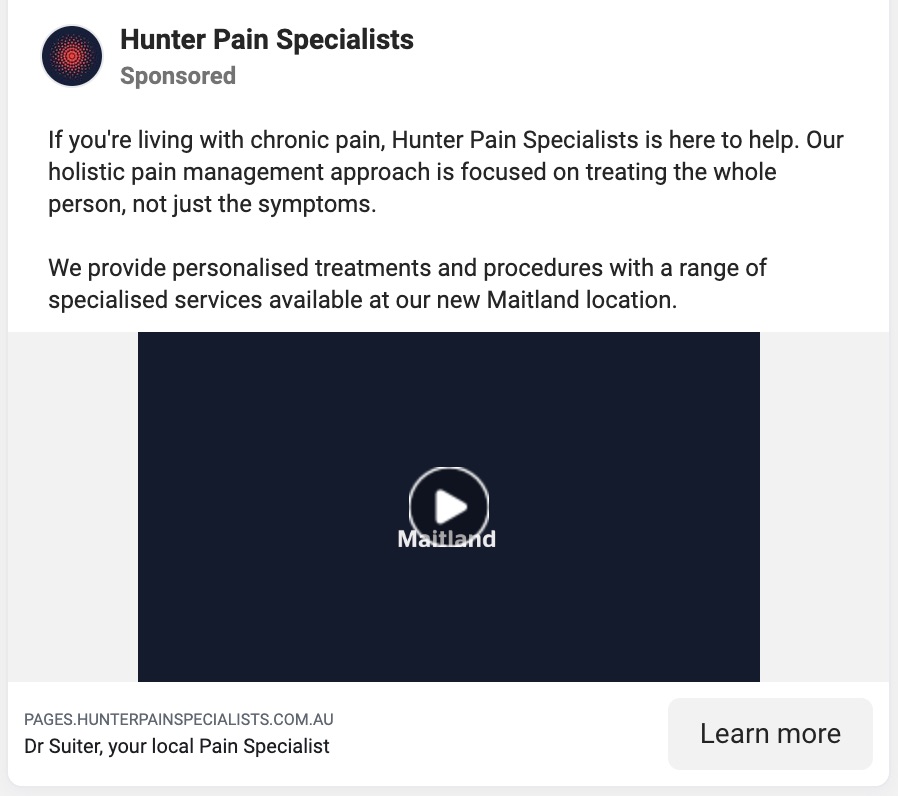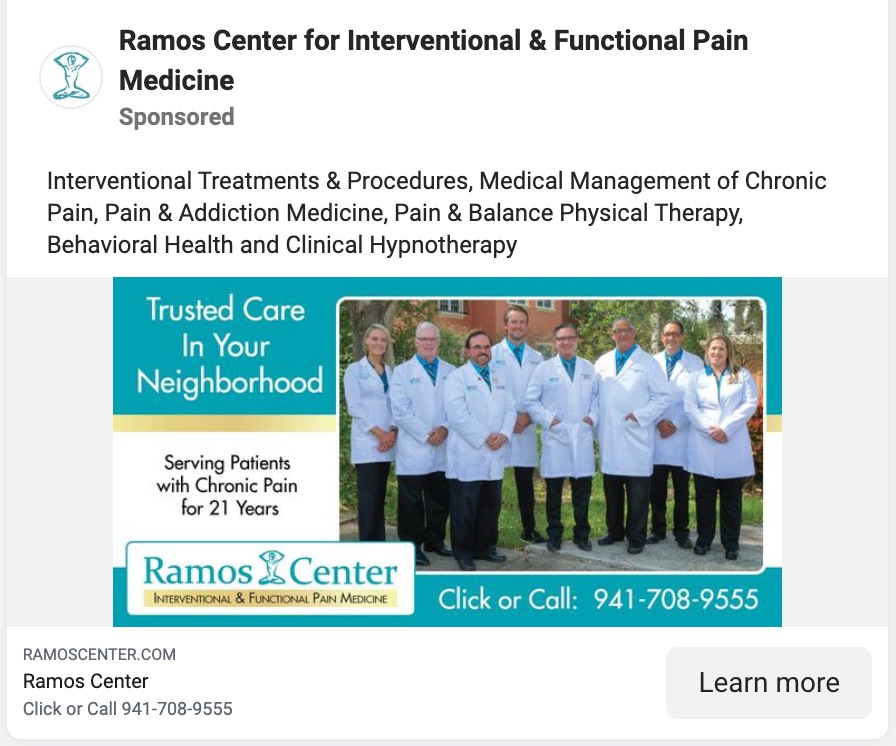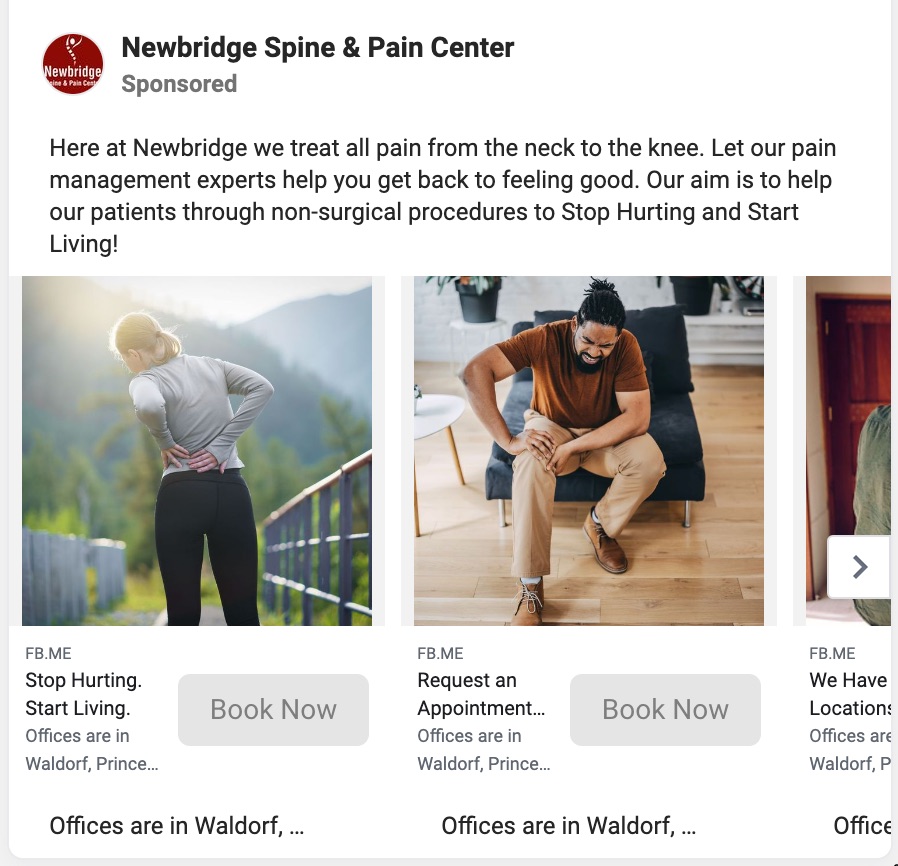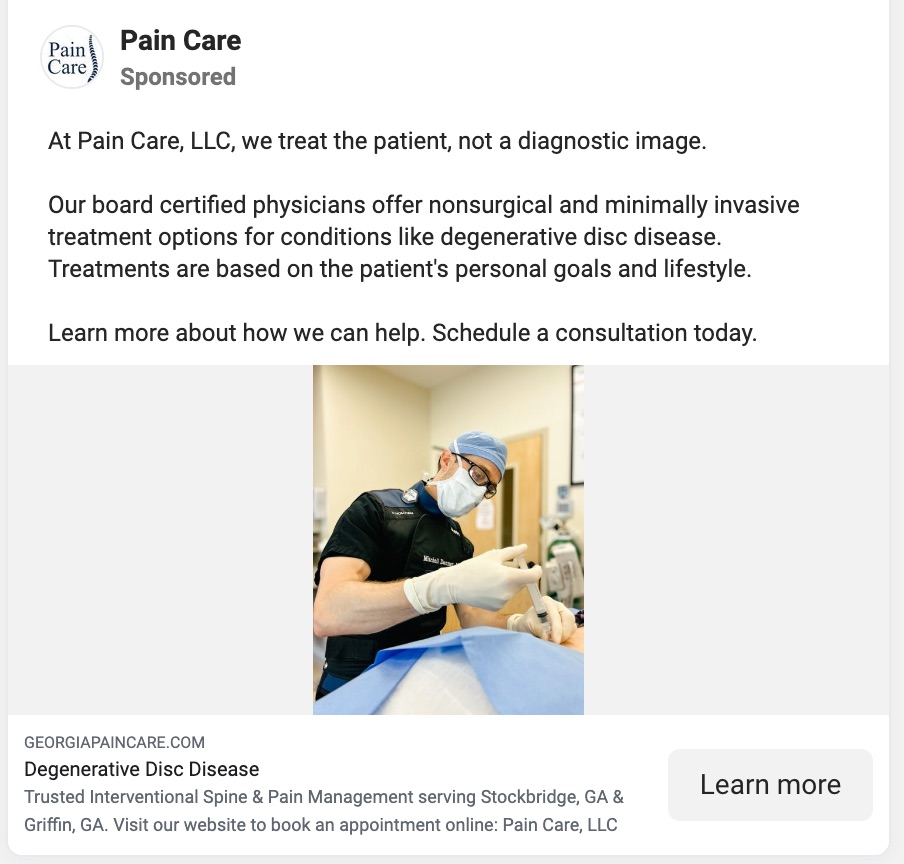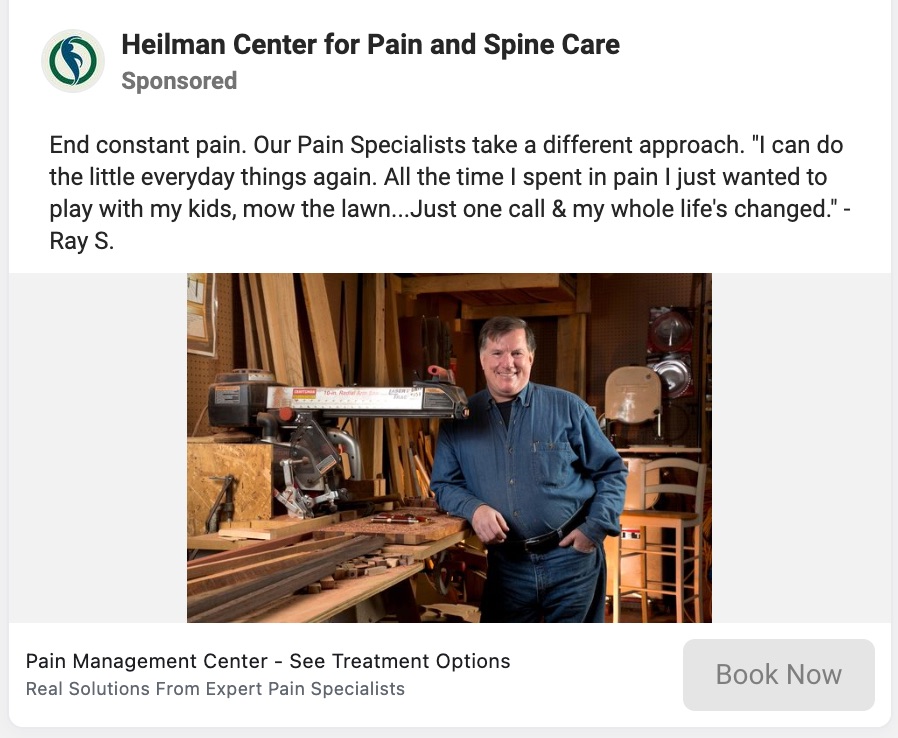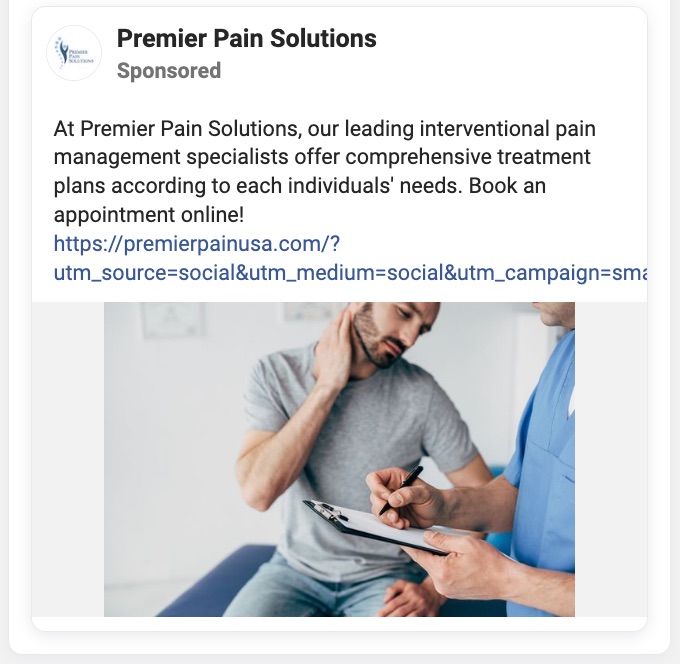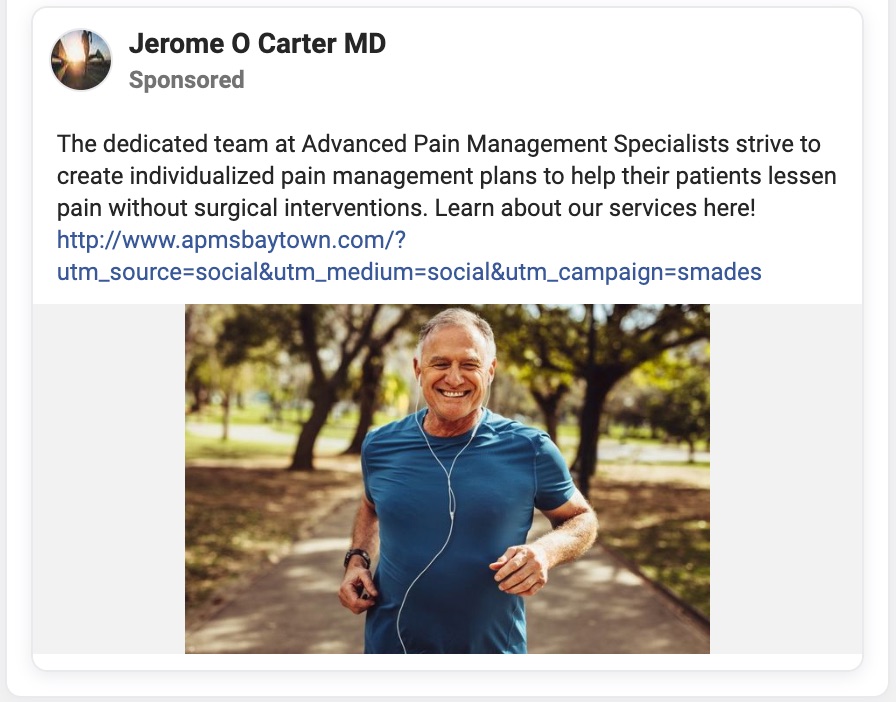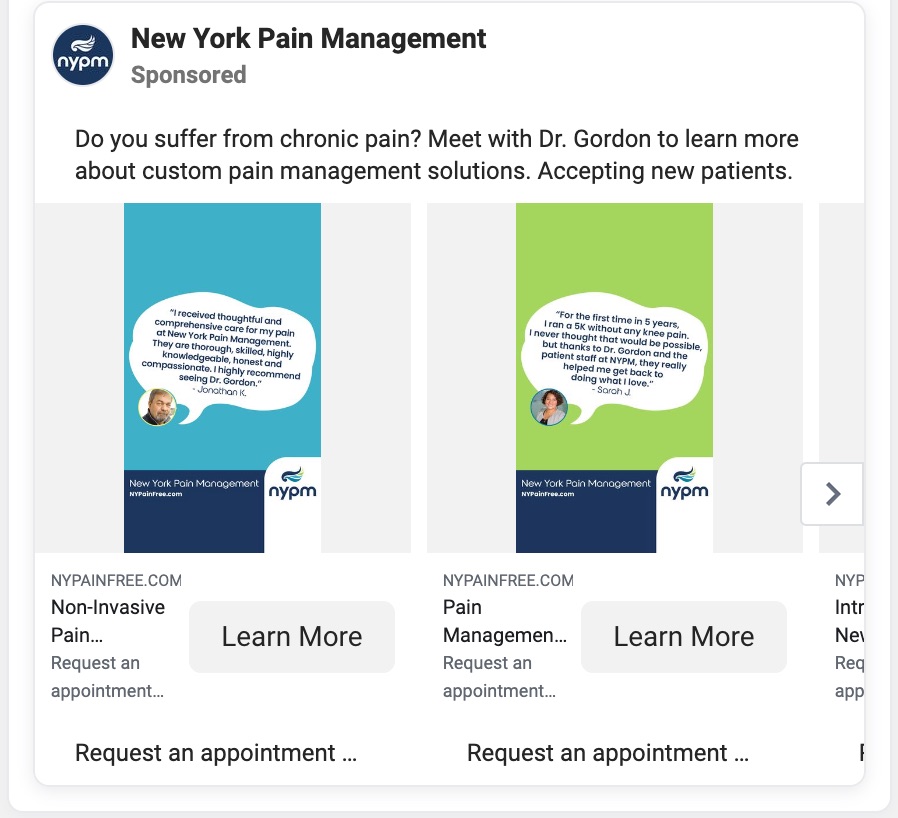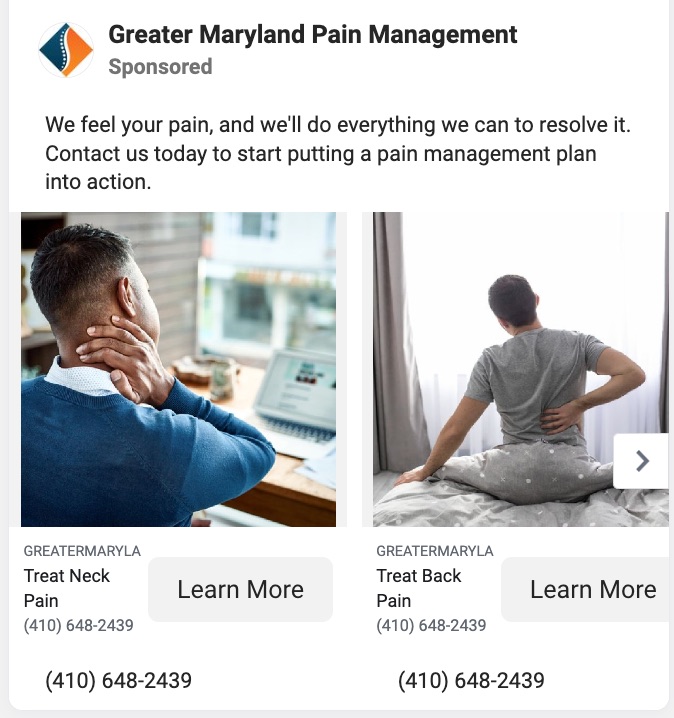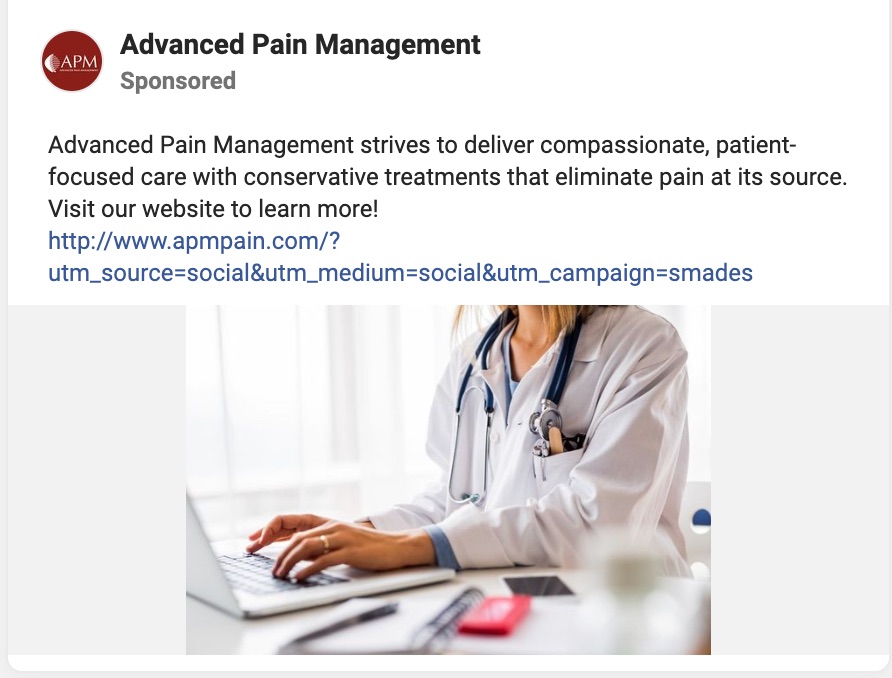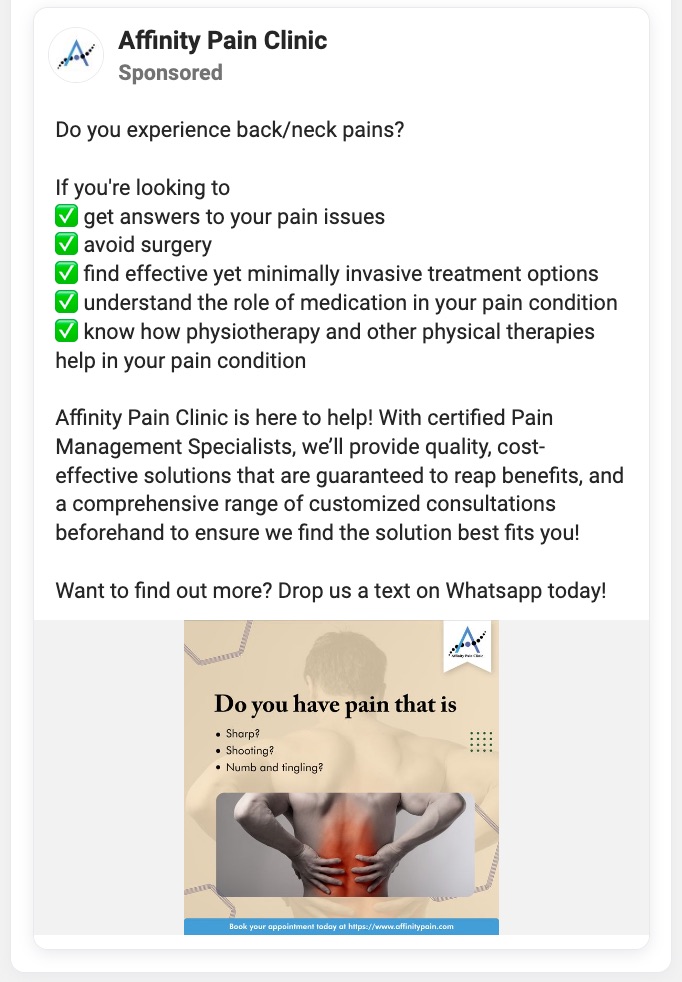I’ve always been a sucker for a good treasure hunt, whether it’s Indiana Jones on TV or finding chocolate eggs for Easter.
So when the hippo wanted help finding good pain management ads for this mini-guide, I didn’t expect it to be harder than finding water in the Sahara desert.
It has been surprisingly challenging to find ads that hooked me, even though there’s plenty of demand for pain relief out there.
The low bar is encouraging since it won’t be difficult for you to stand out. Let’s get a lay of the land, and I imagine you’ll feel the same.
Afterwards, I’ll look at the persuasive elements (like which offers other clinics use) to see what you can take away for your own campaigns.
Table of Contents
Real-world pain management ad examples I’ve found in the wild
Let’s look at pain ads running on Facebook and Google, since those two platforms are the most popular to buy ads these days.
The wise hippo recommended not only including the best ads, but also giving you a lay of the land, so you’ll get a sense of what you’re competing with for good or bad.
The simplest and quickest way to get inspiration from these campaigns is to think about which ones make you want to click on the ad and consider a booking.
Consider elements like the image or video. Does it make you stop scrolling and click the ad? Was the language easy to understand, or did it feel stiff and overly corporate? Did the ad offer something special, like a limited-time discount on a screening?
21 Facebook display ads
First, let’s look at Facebook ad examples.
8 Google search text ads
Next, let’s look at examples from Google ads.
Spark your creativity with these pain management ad insights
If you’re stuck looking for inspiration, let’s take things a step further. Let’s look at the persuasive elements these pain ads use, like patient benefits, offers, and how the clinics stand out from the crowd.
Maybe it’ll spark some of that magic creativity.
You could go back and examine each of the ads, but for your convenience, I’ve gathered the best insights below, starting with the most common angles.
Those are case studies and hard-selling ads going directly to the point.
The hippo pointed out that the best benefits tend to be super specific and relevant to the type of patient they’re targeting. When done right, they make ads feel relatable, like they were made just for you. That relatability makes it effective to hook potential patients.
My favorite benefits were:
- Mow the lawn (who knew that could be exciting!?)
- Pick up your (grand)kids and play with them
- Dance at weddings
- Avoid surgery
- Avoid depression and stop isolating yourself due to the pain and physical challenges
- Non-invasive alternative to taking risky pain management pills
- Get your life back (the quality of life)
Next, let’s dive into the offers that make you want to respond to the ad right then and there. Often, that’s booking an appointment, but in these ads, I didn’t notice much variety. Several of the ads offered a generic discount you’ll see anywhere, or the ads didn’t include any specific offer at all.
For your inspiration, three offers that stood out were:
- Free consultation + MRI review
- Free knee screening voucher
- Spinal decompression treatment discount
Some ads limit these offers to just a few people, which is a powerful technique, but miss an important detail: saying WHY it’s limited… without doing so, it feels like a random number made up to serve the ad.
Some potential patients aren’t aware of their issues and respond better to specific symptoms they can feel. The hippo pointed out that it means they’re at a different stage of awareness, and you’ll get better results by using a different type of message (he recommends reading Eugene Schwartz’s five stages of awareness from the book Breakthrough Advertising).
Not all the ads mentioned symptoms, but the most common ones were:
- Swelling and stiffness (knee)
- Inability to fully straighten the knee (knee)
- Redness and warmth (knee)
- Popping or crunching noises (knee)
Once you’ve hooked the potential patient, show them why your clinic is different. The clinics running the ads you and I looked at used these to stand out from the crowd:
- Accepts insurance/Medicare
- No referral (from an MD) required
- Voted best in X area
- Proven track record
- Years of experience
- Show where the doctor(s) were trained
- The number of positive reviews/votes
- Offering doctor house calls
Did these insights get your creative juices flowing or do you need one of the hippo’s famous mud baths to spark your creativity?
If not, the wise hippo has one last trick up his sleeve…
The hippo’s best tip to understand why your pain ads aren’t converting
Imagine the perfect ad: an enticing video, a mouthwatering hook, and a great offer…
The ad seems perfect, yet it sparks nothing when you’re running it. What’s going on?!
I grilled the hippo for more tips, and he saved the best and simplest one for last: imagine a real person you know who falls into the type of patient you want to reach. It might be a patient you’ve interviewed for research, a colleague, or a friend.
Put yourself in their shoes and imagine what they’d think when they see the ads you’ve created (or the examples in this article). Would they stop scrolling? Would they understand the message? Would it hook them? Would they take you up on the offer?
… Or would they not even notice the ad in the sea of similar ones?
Be honest.
Getting specific with a particular real-world person is an easy way to sense-check if the existing ads resonate with real patients rather than just marketers and colleagues. Sometimes we’ve been working too closely on it and can’t see the forest for all the trees–we’re too deep in the thick of it.
But, say for a minute that it is a terrific ad, where are those damn bookings?!
The hippo points out that it’s all for nothing if you aren’t reaching the right potential patients. Those that you made it for.
The problem is that there are a few “hidden” reasons that are easy to miss.
One is that the ad platforms aren’t as effective at reaching the people you intended as they may appear at first. For example, if you limit your ads to a small neighborhood, you might reach that person after they leave that area as the location detection wasn’t updated frequently enough.
Another is that these platforms tend to add many subtle configurations to cast a wider net and reach the largest number of people. It can be surprisingly hard to find these settings in a dashboard full of configurations.

Thirdly, we might misjudge what certain targeting configurations mean. For example, if you target people fitting the description “pain management” in Google’s display ads dashboard, who do you really reach, and what were the criteria used to judge that they were suitable to fit this group of people?
And when they are not suitable anymore, will Google remove them from the group?

The hippo’s point is that you can’t depend on one targeting configuration to carry your campaigns due to this lack of transparency.
It’s necessary to test and compare the results of several different targeting configurations to make sure your ads are reaching the people you wanted to.
Not being able to play with your kids due to knee pain is an example of a pain point. An example of a pain solution advertisement is promoting a solution that highlights how that problem is solved and what the experience will be like for the patient afterward.
Pain management is popular to promote with ads on social media and Google search due to the targeting configurations available. There are what feels like a million ways to reach the right people and in this article, we’ll explore some of them.
A few examples of pain management could be physical therapy, injections, medication, and exercise.
